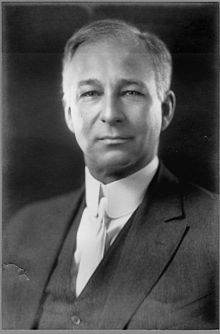Frederick Vernon Coville
Frederick Vernon Coville | |
|---|---|
 | |
| Born | March 23, 1867 |
| Died | January 9, 1937(aged 69) Washington, D.C. |
| Alma mater | Cornell University |
| Known for | Botany of the Death Valley Expedition,Chief Botanist of USDA, Founder of theUnited States National Arboretum,work onblueberry |
| Spouse | Elizabeth Harwood Boyton |
| Children | Five |
| Parent(s) | Joseph Addison and Lydia Coville |
| Awards | HonorarySc.D.fromThe George Washington University,George Roberts White Medal |
| Scientific career | |
| Fields | Botany,agronomy |
| Institutions | USDA |
| Author abbrev. (botany) | Coville |
Frederick Vernon Coville(March 23, 1867 – January 9, 1937) was an American botanist who participated in theDeath Valley Expedition(1890-1891), was honorary curator of theUnited States National Herbarium(1893-1937), worked at then was Chief botanist of theUnited States Department of Agriculture(USDA), and was the first director of theUnited States National Arboretum.He made contribution to economic botany and helped shape American scientific policy of the time on plant and exploration research.
Biography[edit]
Coville was born in 1867 inPreston,New York to bank director Joseph Addison Coville and his wife Lydia. He went toCornell University,where he graduated with a Bachelor of Arts in 1887. He briefly taughtbotanybefore joining the USDA and participating to theGeological SurveyofArkansasas assistant botanist in 1888. He would remain with the department until his death, succeeding toGeorge Vaseyas Chief botanist in 1893, a title accompanied with that of Honorary Curator of the National Herbarium (at the time conserved at theSmithsonian Institution,but funded by the USDA). Coville married his wife, Elizabeth Harwood Boyton, in 1890; they had five children, four of whom, three sons and a daughter, survived their father. Over the course of his life, he published approximately 170 papers and books; he also contributed to botany entries of theCentury Dictionary.A tall man who had enjoyed success in college sports, he was described as helpful, perceptive, clear-thinking and curious, as well as greatly enthusiastic in his outdoor expeditions.
Coville participated in the 1891Death Valley Expeditionled byC. Hart MerriamandT. S. Palmer,his resultingBotany of the Death Valley Expedition(1893) is an important work ondesertplants. He traveled a lot in the Western United States and grew an interest for desert and medicinal plants, leading to his 1897-1898 Medicinal Plants Survey.Gifford Pinchotcalled a report of Coville's on effects ofgrazingon forest "the essentials of a sound and farsighted grazing policy".[citation needed]Coville also participated in and wrote on the 1899Harriman Alaska Expedition,although he never completed hisFlora of Alaska.He was involved with the establishment of theCarnegie Institution's Desert Botanical Laboratory in 1903, the USDA Seed Laboratory, and spearheaded efforts that lead to the foundation of theUnited States National Arboretumin 1927.

Coville was considered the American authority onJuncaceaeandGrossulariaceae.After 1910 he began to work onblueberry,and was the first to discover the importance ofsoil acidity(blueberries need highly acidic soil), that blueberries do not self-pollinate, and the effects of cold on blueberries and other plants.[1]In 1911, he began a program of research in conjunction withElizabeth White,daughter of the owner of the extensivecranberry bogsat Whitesbog in theNew Jersey Pine Barrens.His work doubled the size of some strains' fruit, and by 1916, he had succeeded in cultivating blueberries, making them a valuable crop in the Northeastern United States.[2]For this work he received the George Roberts White Medal of Honor from theMassachusetts Horticultural Society.In 1919, Coville played an instrumental role in drawing attention to the threatened state of the only knownbox huckleberrycolony,[3]sparking a revival of interest that led to the discovery of many new specimens of the plant. From 1920 to his death, he was chairman of theNational Geographic Society' Research Committee and was very influential in deciding areas of exploration. At the time of his death he was working on a revision ofBotany of the Death Valley Expeditionas a flora of the Valley.
Coville's papers are split between several archives. Many (including his revision notes forBotany of the Death Valley Expedition) are kept at the Smithsonian Institution, Others at the National Arboretum. His personal library is now part of theUniversity of Wyoming's special collections library, while his Death Valley Expedition field diary is kept atUC Berkeley.Amongst several plants named after him areEriogonum covilleanum,Amelanchier covillei,Cheilanthes covillei,Sidalcea covillei,Enceliopsis covillei,Juncus covilleiandLupinus covillei.A genusCovilleawas also named after him, but is now considered a synonym ofLarrea.
Publications[edit]
- Of Agriculture, United States. Dept; Herbarium, United States National; Museum, United States National (November 29, 1893)."Botany of the Death Valley Expedition. A Report on the Botany of the Expedition Sent Out in 1891 by the U.S. Department of Agriculture to Make a Biological Survey of the Region of Death Valley, California".Contributions from the U.S. National Herbarium.IV.Washington:Government Printing Office:68.
Notes[edit]
- ^Mirsky, Steve."Early 20th Century Botanist Gave Us Domesticated Blueberries".Scientific American.RetrievedSeptember 21,2013.
- ^"History of White's Bog".Whitesbog Preservation Trust. Archived fromthe originalon May 15, 2008.RetrievedJanuary 11,2008.
- ^Coville, Frederick V.(July 11, 1919)."The Threatened Extinction of the Box Huckleberry, Gaylussacia brachycera".Science.50(1280): 30–34.Bibcode:1919Sci....50...30C.doi:10.1126/science.50.1280.30.JSTOR1641999.PMID17801660.
- ^International Plant Names Index.Coville.
References[edit]
- "Record Unit 7272: Frederick Vernon Coville Papers".Smithsonian Institution Archives.Smithsonian Institution.2002.RetrievedDecember 31,2007.
- Glenn, Susan W. (1997)."Coville, Frederick Vernon".Biographical Dictionary of American and Canadian Naturalists and Environmentalists.Westport: Greenwood Press. pp.177–178.ISBN0-313-23047-1.
- Susan J., Pennington (2004)."The Rebirth of theContributionsSeries "(PDF).The Plant Press.7(4): 1.RetrievedDecember 31,2007.
- Charters, Michael L."CI-CY".California Plant Names: Latin and Greek Meanings and Derivations.RetrievedDecember 31,2007.
- Maxon, William R. (March 1937). "Obituary: Frederick Vernon Coville".Science.85(2203): 280–282.doi:10.1126/science.85.2203.280.
External links[edit]
- Works by Frederick Vernon CovilleatLibriVox(public domain audiobooks)

- .New International Encyclopedia.1905.
- American taxonomists
- Economic botanists
- 1867 births
- 1937 deaths
- United States Department of Agriculture people
- Cornell University College of Agriculture and Life Sciences alumni
- Cornell University faculty
- People from Chenango County, New York
- Scientists from New York (state)
- 19th-century American botanists
- 20th-century American botanists
